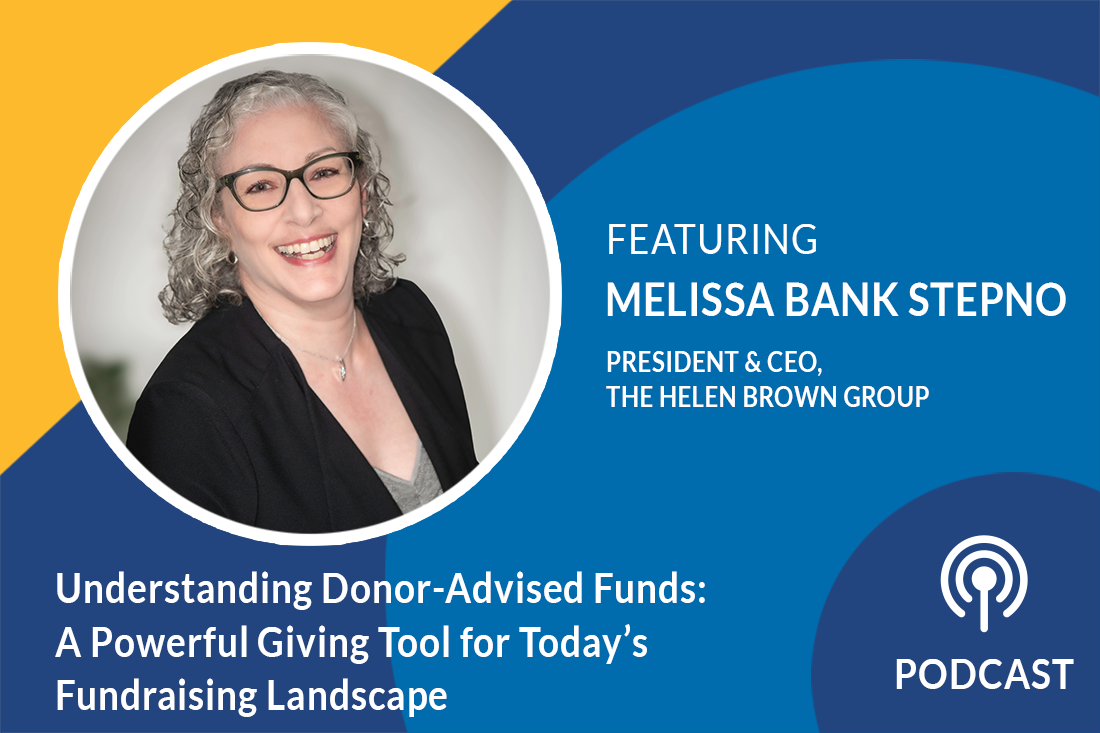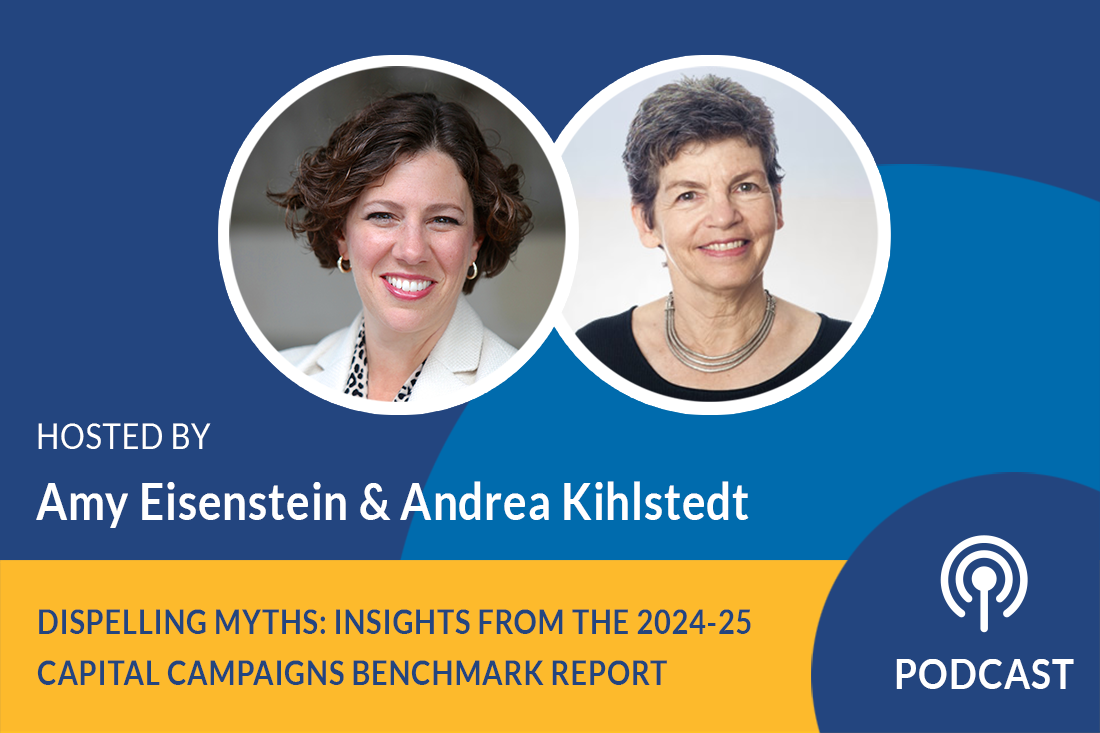Podcast: Excite Your Largest Donors as Philanthropy Investors

Season 2, Episode 64
Are you missing an opportunity to get your largest donors excited? In this episode, campaign experts Amy Eisenstein and Andrea Kihlstedt discuss the importance and how to get your campaign donors truly excited and engaged in the mission of your organization.
Listen Now:
Amy Eisenstein:
Are you missing an opportunity to get your largest donors excited? If so, stick around.
Hi, I’m Amy Eisenstein. I’m here with my colleague Andrea Kihlstedt, and we are here to discuss the importance and how to get your campaign donors truly excited and engaged in the mission of your organization.
Andrea, why don’t you kick us off.
Getting Lead Donors Excited About Your Campaign
Andrea Kihlstedt:
Amy, I love the topic we’ve picked for today, because it’s a paradoxical topic. You may think that talking to the same donors, your lead donors for two gifts would be sort of off-putting. But I think when you talk to your lead donors about their capital campaign gift and an annual fund gift, and how together, those can make a huge difference in the impact of your organization, you actually have a remarkable opportunity.
That when you talk to donors, not from the perspective of your coming to take their money, but from the perspective of they have an opportunity to invest both in terms of the growth of the organization with the capital campaign and the annual operating, so that the organization is going to move to the next level, and be healthy. That’s the opportunity to make your donors feel like they’re true partners in what you’re doing. I think we often miss that. We shy away from it. We miss an opportunity here.
Amy Eisenstein:
I think you’re right. It really is imperative that we’re talking in partnership with these potential donors about the future of the organization, and of the community, and how they really want to be invested and involved. That is twofold. It is both:
- The capital campaign — the growth opportunity
- Getting the organization to the next level [with respect to] sustainability
And making sure that once the organization gets to the next level, that they are able to operate and function at that higher level.
Both gifts are required, and donors should feel great about them once they’ve given. I always like to say that if your donor feels bad the next morning, you haven’t asked correctly, you haven’t asked well. Because they shouldn’t feel like you guilted them into something, or you twisted their arm, or you made them feel bad. They should feel inspired. They should feel like they’re really giving back. They’re part of something bigger than what you had been before.
Donations as Investment Opportunities
Andrea Kihlstedt:
Amy, many organizations that do this really well have a conversation at least once a year with their donors, where they essentially talk about their investment portfolio. Now, I don’t mean what the donors are invested in, in the stock market. What I mean is, how the donors are invested in their organization.
They actually will make a little investment report showing outstanding pledges, for example. Showing that a donor has made a $250,000 gift to the capital campaign, that it’s pledged over five years, and they have paid three of those five pledges of those five payments. They have also pledged in their annual fund gift, or they have given this much in their annual gift over the last years. And then they use that as an opportunity to have a discussion with a donor about what they’d like to do going forward. So, they treat it as though it is an investment, which of course it is. It’s the donor’s investment in your organization, it’s the donor’s investment in their community.
I find that such a wonderful idea to consider, to really consider your largest donors as investors through you in the community you serve. You would never look at a portfolio, an investment portfolio, and imagine that people wouldn’t know what it is they’re doing. It’s the same thing when they give to your organization. That if they are at a level of doing complex gifts that are paid over time in pledges, it’s very easy for them to get confused. Very easy for a donor to forget what they’ve said. If you actually have a conversation with them and say:
“This is what you’ve done. This is what you’ve paid over years. This is the total amount you’ve contributed, and now we want to ask you to consider this.”
That’s a really interesting conversation.
Amy Eisenstein:
Or maybe it’s just even a check-in. If they’re mid-pledge, you’re not asking them to consider anything. You’re using it as a stewardship and a cultivation opportunity to celebrate what they’ve already done, and celebrate what they’ve committed to, and use it as a reminder. And an opportunity to provide updates and get them to ask questions about where you are, and how it’s going. I think this is such an important idea, this investment report.
I don’t know exactly what you’re going to call it. It has to fit the culture of your organization, but that’s the idea. One of the things that we worry about when donors make a multi-year pledge is that a development director will say, “Phew, onto the next donor,” and ignore them for three years. But, if you use this report as an opportunity for an annual check-in, update, celebration, cultivation, stewardship, you will ensure that you talk to your donors at least once a year.
Does the Campaign Cannibalize Your Annual Fund?
Andrea Kihlstedt:
Right. It’s such an important idea. It’s flipside, Amy, of something we’ve talked about on this podcast before, which is the question that we often get about, “Won’t the capital campaign cannibalize my annual fund?” Everyone wants to know that.
“Won’t the capital campaign… With people give to the capital campaign? Are they going to stop giving their annual fund gift?”
Rather than say, “Oh, yes, we have to tread carefully about that,” what we’re saying here is, “You should lean into that.” That when you have people who support you year after year, and support operations, and then they’re going to help you grow to the next level of capital needs. You have the possibility, you have the opportunity to solidify your relationship with them. Not by being worried about it, but by saying:
“Listen, you are one of our key partners in helping us thrive, in helping us do more to take care of our community. We’re so pleased to be able to come to you. Here’s what your investment in us looks like, and here’s what we’d like to invite you to consider.”
It’s a flipside. It takes a shift of your brain to get from being afraid to seeing it as a real opportunity to forge a different relationship with your major donors.
Amy Eisenstein:
Yes. I think that’s such an important idea, because you’re right, so many fundraising professionals, and volunteers think:
“Oh, if I’m asking for a capital gift, I can’t possibly ask for an annual gift.”
But, that’s exactly what you want to do. You want your biggest and best supporters to really understand and embrace this idea, that there are two separate things going on here. There are the capital needs that are going to get you to the next level, as you said, and there’re those critical ongoing expenses, and needs that are happening underneath all throughout your campaign, and will continue into the future. They are a critical piece of that puzzle.
Attitudes Toward Donors Matter
Andrea Kihlstedt:
It’s so important, Amy, that we consider, and reconsider and reconsider again, our attitude towards our donors. That instead of thinking of them as sources of money, we need to think of them as investors with us in making the community we serve better, and helping to accomplish our mission. If we can shift our mindset… It’s not easy.
Again and again, we get sucked into money. We get sucked into how much money can we get? How much money can we twist their arms about? How much money can we go, “Ka-ching” in our annual, in our reports? We lose track of what’s really going on here.
I’ve been working on a campaign, it’s a very successful campaign. Through the campaign, the relationship between the leaders of the organization, and the donors have grown, and grown, and grown. They have raised a lot of money. It has taken a long time. They have gone back to multiple donors again and again. They have involved donors in ad hoc committees.
I think by the end of the campaign though, those donors will have given both capital gifts, and very generous annual gifts. Every donor who did will feel happy to have been a special part of that campaign, because they were treated like partners, like investors. Not like, “Well, let’s see how much money we can get from them.”
Amy Eisenstein:
Yeah, well one thing you didn’t mention is that those donors gave expertise. They were really treated as partners.
Andrea Kihlstedt:
That’s right.
Amy Eisenstein:
They were involved. When there were questions or concerns that came up, the organization leaned on those people for advice, and went to them when they had issues or problems. They didn’t hide or shy away from those things. I think that, that also is a critical piece of the puzzle. It isn’t just about money. It’s also about engaging people in the community in very real and authentic ways.
Andrea Kihlstedt:
Yeah. It’s so fascinating, and I don’t know why it’s so difficult to keep the right mindset, but I know it is. I know it to be difficult. Even for me, it’s easy to flip into money mode rather than partner mode.
Wrapping Up
Just to wrap this, put a point on this. As you talk to your capital campaign donors about an annual gift, or you talk to your annual fund donors about a capital camp gift, rather than being afraid of that, rather than worrying that you’re going to somehow offend them. Instead, shift your mind to thinking about them as investors, as people who will want to invest in the long-term and short-term health of your organization. Because they want you to do the work that they can’t do.
Whatever it is you’re doing in the community, your donors can’t do. Whether you’re taking care of animals, whether you’re taking care of children, whether you’re taking care of elders, whether you’re educating people. What you are doing for your mission is something that the donors by themselves can’t do, and they are investing in that through you. So, can get that as your mindset, as the frame of your conversations. And it will help you not to worry so much about whether asking for two gifts at a time is a problem.
Amy Eisenstein:
Yes. If you want a professional partner to help ensure that you do this well and keep you on track, I would encourage you to visit the Capital Campaign Pro website. Sign up to speak with one of our experts to help determine whether or not we would be a great partner to support you through your campaign.
Thank you for joining us, and we’ll see you next week.



Leave a Comment